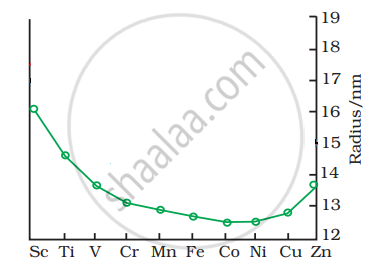Advertisements
Advertisements
Question
In the series Sc (Z = 21) to Zn (Z = 30), the enthalpy of atomization of zinc is the lowest, i.e., 126 kJ mol−1. Why?
Solution
The electrons of the 3d orbitals of zinc are not used in bonding, whereas the electrons of the d orbitals of all the remaining metals of the 3d series are used in forming bonds. Hence the value of the atomization enthalpy of zinc is the lowest in the series.
APPEARS IN
RELATED QUESTIONS
What are interstitial compounds?
The elements of 3d transition series are given as: Sc Ti V Cr Mn Fe Co
Answer the following: Which element has the highest m.p?
The elements of 3d transition series are given as: Sc Ti V Cr Mn Fe Co
Answer the following: Which element is a strong oxidising agent in +3 oxidation state and why?
In what way is the electronic configuration of the transition elements different from that of the non-transition elements?
Write down the number of 3d electrons in the following ion:
Cu2+
Indicate how would you expect the five 3d orbitals to be occupied for this hydrated ions (octahedral).
Complete and balance the following chemical equations
`Fe^(2+) + MnO_4^(-) + H^+ ->`
Give reasons: E° value for the Mn3+/Mn2+ couple is much more positive than that for Fe3+/Fe2+.
Electronic configuration of Mn2+ is ____________.
Generally transition elements form coloured salts due to the presence of unpaired electrons. Which of the following compounds will be coloured in solid-state?
Transition elements show magnetic moment due to spin and orbital motion of electrons. Which of the following metallic ions have almost same spin only magnetic moment?
(i) \[\ce{Co^{2+}}\]
(ii) \[\ce{Cr^{2+}}\]
(iii) \[\ce{Mn^{2+}}\]
(iv) \[\ce{Cr^{3+}}\]
Out of \[\ce{Cu2Cl2}\] and \[\ce{CuCl2}\], which is more stable and why?
Answer the following question:
Which element of the first transition series has highest second ionisation enthalpy?
Read the passage given below and answer the following question.
|
Are there nuclear reactions going on in our bodies? There are nuclear reactions constantly occurring in our bodies, but there are very few of them compared to the chemical reactions, and they do not affect our bodies much. All of the physical processes that take place to keep a human body running are chemical processes. Nuclear reactions can lead to chemical damage, which the body may notice and try to fix. The nuclear reaction occurring in our bodies is radioactive decay. This is the change of a less stable nucleus to a more stable nucleus. Every atom has either a stable nucleus or an unstable nucleus, depending on how big it is and on the ratio of protons to neutrons. The ratio of neutrons to protons in a stable nucleus is thus around 1 : 1 for small nuclei (Z < 20). Nuclei with too many neutrons, too few neutrons, or that are simply too big are unstable. They eventually transform to a stable form through radioactive decay. Wherever there are atoms with unstable nuclei (radioactive atoms), there are nuclear reactions occurring naturally. The interesting thing is that there are small amounts of radioactive atoms everywhere: in your chair, in the ground, in the food you eat, and yes, in your body. The most common natural radioactive isotopes in humans are carbon-14 and potassium-40. Chemically, these isotopes behave exactly like stable carbon and potassium. For this reason, the body uses carbon-14 and potassium-40 just like it does normal carbon and potassium; building them into the different parts of the cells, without knowing that they are radioactive. In time, carbon-14 atoms decay to stable nitrogen atoms and potassium-40 atoms decay to stable calcium atoms. Chemicals in the body that relied on having a carbon-14 atom or potassium-40 atom in a certain spot will suddenly have a nitrogen or calcium atom. Such a change damages the chemical. Normally, such changes are so rare, that the body can repair the damage or filter away the damaged chemicals. The natural occurrence of carbon-14 decay in the body is the core principle behind carbon dating. As long as a person is alive and still eating, every carbon-14 atom that decays into a nitrogen atom is replaced on average with a new carbon-14 atom. But once a person dies, he stops replacing the decaying carbon-14 atoms. Slowly the carbon-14 atoms decay to nitrogen without being replaced, so that there is less and less carbon-14 in a dead body. The rate at which carbon-14 decays is constant and follows first order kinetics. It has a half-life of nearly 6000 years, so by measuring the relative amount of carbon-14 in a bone, archeologists can calculate when the person died. All living organisms consume carbon, so carbon dating can be used to date any living organism, and any object made from a living organism. Bones, wood, leather, and even paper can be accurately dated, as long as they first existed within the last 60,000 years. This is all because of the fact that nuclear reactions naturally occur in living organisms. |
Why is Carbon-14 radioactive while Carbon-12 not? (Atomic number of Carbon: 6)
The element with atomic number 53 belongs to
Which of the following statements is not correct?
The spin magnetic moment of cobalt in the compound Hg [Co(SCN)4] is:-
Give reasons for the following statement:
Transition metals and most of their compounds show paramagnetic behaviour.
The oxidation state of Fe in [Fe(CO)5] is ______.
Account for the following:
Sc3+ is colourless whereas Ti3+ is coloured in an aqueous solution.
The trend of which property is represented by the following graph?

